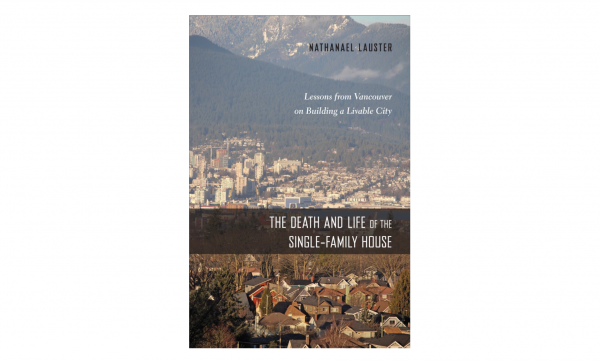
Author: Nathaniel Lauster (Temple University Press, 2016)
In The Death and Life of the Single Family House: Lessons from Vancouver on Building a Livable City, UBC sociology professor Nathanael Lauster explores how and why a Vancouverites now accept the idea that condos or townhouses are every bit as much of a home as a single-family homes. He explains how our city has moved away from the single-family house, and how many people are successfully making themselves at home without a house.
 The first half of the book focuses on how North American cities created so much habitat for houses and continue to protect it via zoning restrictions. Lauster explores how the rise of the single family housing is largely a result of regulatory decisions and discusses how these decisions continue to impact the shape and livability of North American cities.
The first half of the book focuses on how North American cities created so much habitat for houses and continue to protect it via zoning restrictions. Lauster explores how the rise of the single family housing is largely a result of regulatory decisions and discusses how these decisions continue to impact the shape and livability of North American cities.
While the book has important lessons for all North American cities, Lauster focuses his research on Vancouver. The book explains how since the 1960s Vancouver has transitioned from having the highest percentage of its population living in single family houses to one of the lowest on the continent. In 1961, 70 percent of housing in the region were detached houses with yards. Today, it is 34 per cent. Over this timeframe, Vancouver has introduced several alternative housing formats that have helped to curb sprawl and led the city to be recognized as one of the “most livable” in the world.
But the policy and planning and regulatory implications of our housing choices only tell part of the story. As a sociologist, Lauster is most interested in how people define what home means to them. While housing is a very pressing policy issue, it is also a very personal issues for many. Thus, the true strength of the book lies neither with explaining the history of housing typologies in Vancouver nor its comparisons with other cities, but in understanding how the detached house came to define home for so many, and how that is changing.
Lauster gets at this through personal interviews with a wide cross-section of Vancouver residents living across a diverse range of housing forms. He interviewed dozens of Vancouver residents to learn about the types of habitat that houses create for people in big cities today. These interviews provide insight into the historic, economic and cultural importance of the house. These interviews also examine our understandings of housing and how a house does not always equal a home.
We really have this idea that if you want to consider yourself a success in life, you should be living in a single family house. – Nathan Lauster
Through his research, Lauster has developed a belief that the “death” of the single family house is the key to much of the “life” that makes Vancouver so livable. He explains how detached houses—surrounded by lots of private and little public space—can deaden city life. Additionally, lengthy commutes, social isolations and maintenance chores can lead to a further withdrawal from the social life of cities. A number of his interviewees rejected the single-family house in favour of alternative visions of the “good life.” Many of the people living in apartments with families, that Lauster interviewed, expressed their happiness about how they mingle more with neighbours, got out to parks and community centres more often, and generally enjoyed their neighbourhood.
The Death and Life of the Single Family House illustrates how Vancouver’s housing diversity allows the city’s residents to share the cultural diversity, amenities and stimuli of the urban core. This has help bring “life” into our city and society through access to communal spaces, encouraging people to share and engage with others. Lauster proposes that civic vitality thrives when private and public spaces are balanced; when people have places to go and things to do, near their homes. This also promotes people to getting out of the private cocoon of their automobile and engage with their community as the walk or bike or take transit to get to where the want to go.
Vancouver provides the cultural scaffolding for many people to reinterpret their lives as success stories even when they do not own houses. – Nathan Lauster
While the book is based on a case study of Vancouver, it will have resonance with other cities facing housing affordability challenges. There are lessons in this book for the rest of North America on how cities can be built differently, without sacrificing their livability. The Death and Life of the Single Family House is a unique and important contribution to the urbanist canon, and is an important read for civic historians, city planners and urban sociologists, alike.
***
For more information on The Death and Life of the Single Family House: Lessons from Vancouver on Building a Livable City, visit the publisher’s website.
**
Yuri Artibise is an experienced community and digital engagement specialist with a passion for urban planning, public participation and social media. He is the Executive Director of the Vancouver City Planning Commission, and is the principal at Yurbanism, a strategic communications and urban engagement consulting practice.




